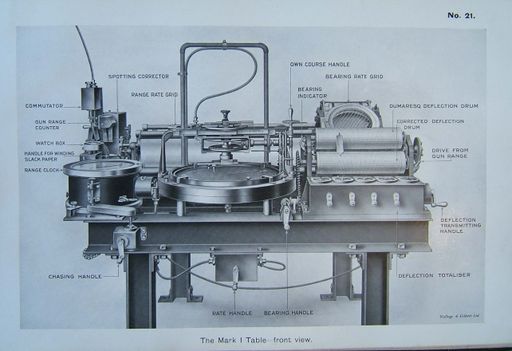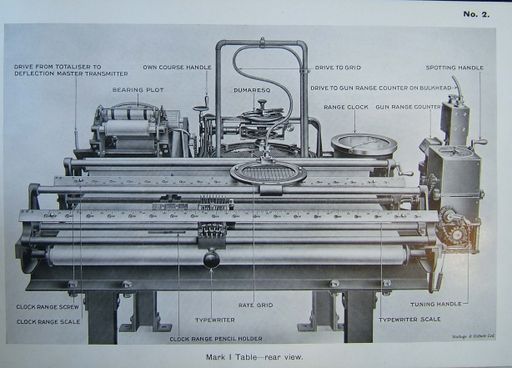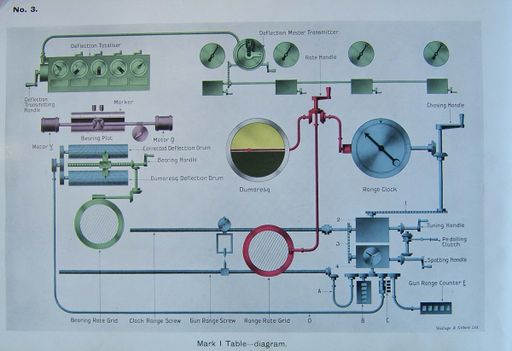Dreyer Table Mark III
The Mark III Dreyer Table was a refined version of the Original Dreyer Table and was the first Dreyer Fire Control Table provided for naval service. Mark III table, and probably first deployed in 1915.[1] With a footprint 23% smaller than the Mark III table's,[2] it could more comfortably fit within the smaller transmitting stations of the early dreadnought battleships and battlecruisers into which it was retro-fitted.
Contents
Development
Five of what was to become known by March 1914 as the Mark III tables were ordered in February 1912 even as the design was being finalised. It generally resembled the capabilities of the original Dreyer table, but by March 1912, it boasted these improvements:
- the paper plots were now driven by electric motors (with a fallback to hand crank)
- the components reorganized to place the bearing plot on the left, dumaresq in centre and range plot on right
- dumaresq now had a means to have a gyro-compass relay update own ship's heading
- a backboard was fitted to display a gyro-compass receiver and Forbes Log.
- a cylindrical deflection drum was added to the bearing plot to relate bearing rate to Dumaresq Deflection.
By February 1913, the design had further matured:(TH page 47-48)
- A bearing clock was added to help keep dumaresq updated for enemy bearing.
- A second deflection drum was to be added to the bearing plot to relate bearing rate to Gun Deflection.
- Automatic transmission of ranges to the guns. The design drawing for what would later be called
- The differential gear (later known as the spotting corrector) considered optional in previous drawings was to be issued with all further tables.
- A means of factoring in own ship's lateral slip through the water as it turns (it is not clear that this ever materialised — it was handled inelegantly even in postwar use of late model Dreyer tables[Citation needed]).
- Plans to relay enemy heading and range rate to the control position (possibly this was considerably delayed, later to be manifested as ''The Repeater'' outlined in the 1918 Handbook.
- A Time-of-Flight corrector for gun range was mentioned, but a lack of further mention of it suggests that this was handled by the separate Dreyer Calculator throughout the war.
- Vague allusion to plans to permit the plotting of cuts from multiple rangefinders
| Overall Dimensions (1918)[3] | |
| Width | 9 feet, 1.5 inches |
| Depth | 4 feet, 2 inches |
| Height of Range Rate Grid | 3 feet, 5 inches |
| Height of top of dumaresq | 5 feet, 9 inches |
Motive Power
Power for drawing paper through the plots and the range and bearing clocks was provided by an electric motor with a speed governor. Should power fail, an alternate hand-drive placed behind the table could be used. The person working this handle observed a stop-watch in a box behind an etched glass cover which revolved as he worked his handle. By keeping the etching in line with the stopwatch's hand, the correct speed to regulate the table's activity was delivered.
The Mark III's power source established a design pattern followed closely by later models except the Mark I and Mark I* which relied solely on hand crank power.
Dumaresq
An adapted Dumaresq Mark VI* with fixed and simplified dial plate was fitted, with a means of permitting the gyro-compass to maintain own heading.
Range Clock
The range clock was underneath the dumaresq and the handle for setting its range rate also moved an indicator in a slot along the line of bearing in the dumaresq's fixed dial plate. In this arrangement, when the operator kept this indicator in line with the dumaresq's enemy bar indicator, he was maintaining a consistent range rate for the hypothesis established by the present dumaresq configuration.
The range clock's output shaft fed a differential which drove the carrier for the red clock range pencil across the range plot and permitted a tuning handle to quickly position the pencil to the desired range.
Bearing Clock
A bearing clock was probably also underneath the dumaresq for every Mark III table delivered. Despite its fairly late appearance in design specifications, the handle for setting a bearing rate is clearly visible in drawings dating back to June 1912. (TH Fig. 7.)
The clock could be set to any rate between +/- 15 degrees per minute by a handle with an indicator scale jutting out from the base of the dumaresq housing (TH Fig 3 & 7).
Spotting Corrector
The spotting corrector in the 1918 handbook features:
- Output worm shaft for the plot range pencil holder
- Spotting handle to enter corrections
- Straddle correction hand (for applying corrections from a Dreyer Calculator)
- Gun range counter (on the table)
- Commutator to relay gun range to control positions and conning tower
- A flexible shaft to carry gun range to the deflection drums of the standard bearing plot
but lacked a flexible shaft to convey the gun range to a Range Master Transmitter on the bulkhead.[4] Presumably, this transcription was done by reading aloud the ranges on the gun range counter.
A hand-worked pedalling clutch located near the tuning handle allowed the plotted range to be tuned without altering the gun range.
Range Plot
The Mark III's range plot set the pattern for those on the later Mark IV, IV* and V tables, a large surface placed on the right, with a range rate grid positioned over it.
Rate Grid The rate grid grew in sophistication by war's end, from one that had irregular markings to translate its wire angles to range rates to one with linear range rate markings, a flexible shaft to keep it aligned to the rate on the range clock, and a means of temporarily deflecting it to explore rates at variance with that set on the clock.
Plotting Range Cuts Like most of the tables, the Mark III tables' means of plotting range cuts evolved over time:
- Initially, a single Argo RF's ranges were plotted in a fully automatic manner. This mechanism could be disconnected in favor of manual penmanship should it fail or should the results of more (or simply other) RFs want to be plotted.
- Ambitions for replacing this with a means of plotting cuts from multiple RFs were probably alluding to the failed Macnamara's Plotter.
- Manual Brownrigg Keyboards were used on many Dreyer tables by Jutland, but it is unclear which Mark III tables might have had this in place of their initial automated plotting mechanism.
- Manual Range Typewriters were being urged for widespread deployment by 1918.[1]
Range Pencils Initial production tables had a single red pencil to plot Clock Range. As early drawings imply it was first installed, it appears that the tuning handle had no pedalling clutch and so intrinsically altered clock range and gun range when it was used. This implies that the tuning handle would only be used at the beginning of an encounter.
Usborne 48-9
| Plotting Ranges | 2,000 - 16,400 yards (a +8,000 yard extended scale added later allowed plotting to 24,400 yards) (DH p. 17.) |
| Paper width | 36 inches |
| Scale | 400 yards/inch |
| Paper speed | 2 inches / minute |
Bearing Plot
On plans drawn up in 1912-1913 and outlined in a Technical History drafted by Dreyer, the bearing plot was on paper 15 inches wide with a simple rate grid whose irregular edge markings as it was rotated converted the angle of rotation into a number of degrees per minute of bearing rate. By February, 1913, a single deflection drum could convert the bearing rate of the grid's inclination to a gun deflection.[5]
The Handbook for Capt F.C. Dreyer's Fire Control Tables, 1918 indicates that these were at some point to be provided with standard bearing plots[6], but these units received such scant service before the introduction of G.D.T. gear that it is hard to bank that many were actually fitted.
Deployment
The Dreyer Handbook of 1918 lists some ships with Mark I tables, with those no longer in active service crossed out by hand at some later date, and those lost before promulgation not listed at all. Those appearing in that document are footnoted below[7].
In February, 1916 Dreyer was awarded £5,000 by the Ordnance Council for his contributions to fire control. A list was drawn up which indicated the "Ships in which Dreyer's Fire Control is fitted or being fitted." Those ships listed under the heading "MARK I (Simple Mechanical Table...)" in this document[8] are footnoted below.
[TO BE CONTINUED - TONE] replace table
| Ship using Mark I table | Date equipped | Notes |
| Dreadnought[7][8] | mid 1916, perhaps by May 25[9] | installed in fore TS |
| Colossus[7][8] | N/A | |
| Hercules[7] | Replaced the Original Dreyer Table used in this ship[10] | |
| Neptune[7][8] | ??? | |
| Collingwood[7][8] | ??? | |
| St. Vincent[7][8] | ??? | |
| Vanguard[8] | ??? | |
| Agincourt[7] | ??? | |
| Erin[7][8] | ??? | |
| Bellerophon[7][8] | before Jutland[1] | |
| Marlborough[7][8] | ??? | |
| Superb[7][8] | ??? | |
| Temeraire[7][8] | ??? | |
| Australia[7][8] | ??? | |
| New Zealand[7][8] | perhaps after Jutland?[1] | |
| Inflexible[7][8] | ??? | |
| Invincible[7] | ??? |
See Also
Footnotes
- ↑ 1.0 1.1 1.2 1.3 Brooks. Dreadnought Gunnery and the Battle of Jutland. p. 176.
- ↑ Handbook of Captain F.C. Dreyer's Fire Control Tables, 1918. p. 90.
- ↑ Dreyer Handbook p. 90.
- ↑ Handbook of Captain F.C. Dreyer's Fire Control Tables, 1918. p. 15.
- ↑ , pPollen Aim Corrector System, Part I. Technical History and Technical Comparison with Commander F. C. Dreyer's Fire Control System, pp. 47-8.
- ↑ Handbook for Capt F.C. Dreyer's Fire Control Tables, 1918. pp. 13-15.
- ↑ 7.00 7.01 7.02 7.03 7.04 7.05 7.06 7.07 7.08 7.09 7.10 7.11 7.12 7.13 7.14 7.15 7.16 Handbook of Captain F.C. Dreyer's Fire Control Tables, 1918. p. 3.
- ↑ 8.00 8.01 8.02 8.03 8.04 8.05 8.06 8.07 8.08 8.09 8.10 8.11 8.12 8.13 8.14 "With 'Extract from Recommendations of the Admiralty Members of the Ordnance Council at a Meeting 10.2.16 concerning Dreyer's award' in DRYR 2/1." Brooks. Dreadnought Gunnery at the Battle of Jutland. pp. 175-176.
- ↑ Roberts. Anatomy of the Ship: The Battleship Dreadnought. p. 31.
- ↑ Pollen Aim Corrector System, Part I. Technical History and Technical Comparison with Commander F. C. Dreyer's Fire Control System, p. 12.
Bibliography
- Template:BibUKDreyerTableHandbook1918
- Template:BibBrooksDreadnoughtGunnery
- Template:BibBrooksThesis
- Template:BibRobertsAnatomyDreadnought
- Template:BibUKTechnicalHistoryComparisonArgoAndDreyer



